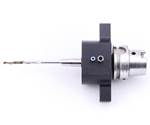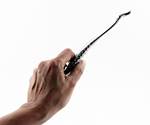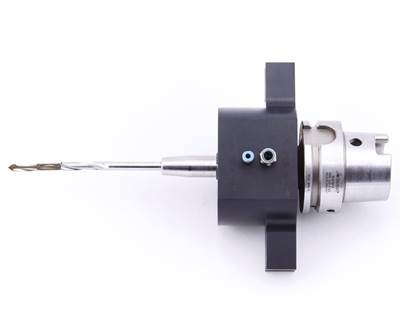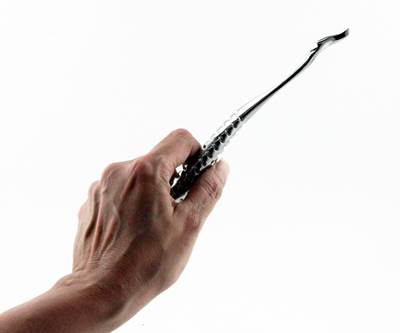Video: Smith & Nephew on 3D Printing Patient-Specific Surgical Instruments
Using MRI and additive manufacturing to produce a cutting block customized to the patient aids the precision of the surgery.
Medical device maker Smith & Nephew is using MRI measurements of knee-replacement patients in conjunction with 3D printing to make a “cutting block” that is tailored to the precise dimensions of the patient. The custom instrument aids the precision and efficiency of a surgical procedure that is becoming increasingly common. Smith & Nephew’s Mark Morrison discussed this custom surgical tooling in a conversation we filmed at the Additive Manufacturing Conference.
Transcript:
Peter Zelinski, Additive Manufacturing
I'm Pete Zelinski with Additive Manufacturing magazine. And I am here with Dr. Mark Morrison, who is manager of research and tribology with Smith & Nephew. Mark, Smith & Nephew is using 3D printing to make instruments that reduce the time and trauma of surgical procedures many of us are very familiar with. What is the surgical procedure and describe the instrument.
Mark Morrison, Smith & Nephew
So, we have these patient-specific instruments for total knee arthroplasty or knee replacement, and so we take imaging from the patient before surgery. We construct a model of their bone, then we create a patient-specific additive-manufactured cutting block or instrument, essentially, that we print and ship to the hospital for the surgery and the surgeon uses that. It fits like a glove, basically, on the patient's bone, and helps a surgeon precisely place cuts. And, better, be more efficient in the OR with that surgery and hopefully more precise in the implantation of that device.
Peter Zelinski
Custom fit to the patient. Can you describe that process? How is the patient measured and how does that result in a customized tool?
Mark Morrison
Right, so we use…. At Smith & Nephew, we use MRI imaging of that patient, and so MRI takes high-resolution images of anatomy in slices, so we segment those slices to segment bone and everything else. We take those slices of bone and create a 3D model of that patient's bone and then we can do many iterations of planning the surgery. We can tweak the surgical plan and see what works best for this patient. We propose that plan to the surgeon. And ultimately, he signs off on what he's happy with and then we use that model and that surgical plan to design this patient-specific instrument.
Peter Zelinski
So, you use the word “instrument.” Our audience—manufacturers—would think of it as tooling. You're creating tooling that is geometrically customized to the patient. And I wonder if you could talk to me about that from the patient's perspective. Why is it so valuable to have patient-matched instrumentation?
Mark Morrison
The placement of that implant in the body relative to the patient's anatomy is very important to the performance of that joint. With the patient-specific instrument we can better control that. We can help the surgeon plan, number one, and two, better implant it in the right place and hopefully provide better longevity of that implant for that patient.
Peter Zelinski
What is the material the instrument is made out of and what machine do you produce it on?
Mark Morrison
We're using an EOS 3D printer or additive manufacturing system and we're printing those devices out of nylon.
Peter Zelinski
All right, so we've been talking about tooling for surgery, customized instruments. Smith & Nephew uses additive also to make implants. Can you talk about that?
Mark Morrison
Yeah, so at the beginning of 2016 we launched our first additive-manufactured implant. It’s an acetabular shell for a hip replacement and additive, what that's allowed us to do in that space is to create our own proprietary porous structure. Additive provides the opportunity to custom-design what that surface feels like and looks like and how it grabs onto the bone and holds that device in place.
Related Content
Overcoming Challenges with 3D Printing Nitinol (and Other Oxygen-Sensitive Alloys) Through Atmospheric Control
3D printed nitinol has potential applications in dental, medical and more but oxygen pickup can make this material challenging to process. Linde shares how atmospheric monitoring and the use of special gas mixtures can help maintain the correct atmosphere for printing this shape alloy and other metals.
Read More3D Printed PEEK Spine Implants in Production: The Cool Parts Show Bonus
Curiteva is using Fused Strand Deposition to produce two different lines of FDA-cleared spine implants. We visited the company’s Huntsville, Alabama, facility to learn more.
Read More3D Printed Spine Implants Made From PEEK Now in Production
Medical device manufacturer Curiteva is producing two families of spinal implants using a proprietary process for 3D printing porous polyether ether ketone (PEEK).
Read More8 Cool Parts From Formnext 2023: The Cool Parts Show #65
New additive manufacturing technologies on display at Formnext were in many cases producing notable end-use components. Here are some of the coolest parts we found at this year’s show.
Read MoreRead Next
3D-Printed Medical Drills Keep Bone Cool During Surgery
Drills made via additive manufacturing cut bones without causing thermal-induced damage thanks to internal cooling channels.
Read More3D-Printed Metal Device Makes ACL Knee Surgery More Accurate
Additive manufacturing made it possible to produce a medical tool that offers surgeons better control during ACL repair or replacement surgery.
Read MoreProfilometry-Based Indentation Plastometry (PIP) as an Alternative to Standard Tensile Testing
UK-based Plastometrex offers a benchtop testing device utilizing PIP to quickly and easily analyze the yield strength, tensile strength and uniform elongation of samples and even printed parts. The solution is particularly useful for additive manufacturing.
Read More





















